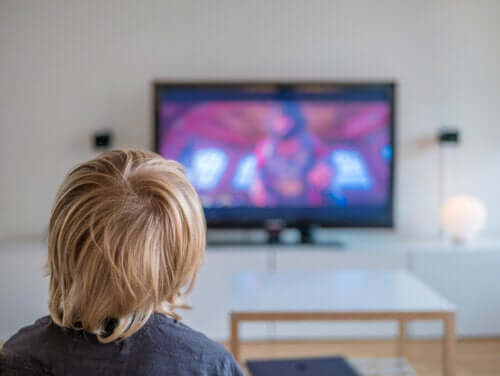The Negative Effects of Screen Time on Children

The amount of time children spend looking at screens is worrisome. Children don’t seem to get tired of watching television or playing with an iPad. This obsession with gadgets is a cause for concern, but the immediate concern is the adverse effects of screen time on their sight.
Children use devices to play games, chat, use the Internet, or watch movies. The activity is usually so interesting for them that they don’t divert their attention from the screen.
Effects of too much screen time
They also don’t pay attention to things such as posture, distance from the screen, and screen brightness, which can negatively affect their sight and health. Too much screen time causes discomfort. Problems such as dry eyes and eye irritation manifest, and they can also find it difficult to concentrate for some time after having spent a long period looking at screens.
Spending too much time in the same posture can also cause neck and back pain. If you find it difficult to deal with screen time, imagine what must happen to your child’s eyes. Digital devices have become an inseparable part of life. You may not want them to disappear entirely because this is impossible, but you can minimize their impact on your children.

More consequences of too much screen time
The first step is to understand what you’re dealing with. An average child spends approximately eight hours a day looking at electronic displays. The use of gadgets among children increases with age. Although experts aren’t sure of this fact yet, children who spend too much time looking at screens are at an increased risk of long-term vision problems.
In addition to TVs and video games, most devices arose in the last two decades. While you can see the immediate effects on children, their long-term effects are unknown.
It’s likely that children who spend too much time on devices develop temporary myopia. Fortunately, the effect is transient and the eyes recover a few minutes after switching to another activity.
The effect of spending a lot of time looking at screens isn’t limited only to the eyes. In addition to symptoms such as dry eyes, burning sensation, double vision, and blurred vision, people also complain of headaches and posture problems, such as back and neck pain.
Doctors now call this set of symptoms “computer vision syndrome” or CVS. When people look at electronic displays, they blink less. On average, a person blinks about 15 times a minute.
Due to the great attention the use of gadgets and electronic displays requires, this rate may drop to less than five times a minute. Blinking is a natural mechanism that keeps the eyes moist, lubricated, and clean.
A lower blink rate causes dry eyes and irritation. Its severity varies according to the type of activity and the level of commitment. Therefore, a video game causes more eye strain because you have to constantly look at and respond to what’s happening on the screen.
Desktop computers and wall-mounted televisions can make things worse because they make you look up. This makes you open your eyes more and overexpose the surface of the eye to the evaporation of tears.
Electronic displays can produce bright and contrasted images, and these images can vary in a split second. Also, they reflect the brightness of surrounding light sources, such as lamps and windows. Thus, your eyes have to frequently respond to changing light levels.

Beware of blue light and eye fatigue due to gadgets
Looking at a screen that’s too dim or bright compared to the environment also causes eye strain. Your eyes have to adjust when you change from the screen to your surroundings. The frequent pupillary dilation and constriction cause eye fatigue.
Most modern devices come with LED screens because they produce brighter images and consume less energy. However, the amount of blue light these screens emit is concerning.
LED screens emit much more blue light compared to LCD screens. Although research is limited, many optometrists suspect that blue light can cause irreversible damage to the retina.
This can increase the risk of macular degeneration and cataracts. The macula is the central part of the retina and is crucial for good sight. Macular degeneration can make everyday activities, such as reading and driving, impossible.
With age, the lenses of the eyes begin to turn yellow. For adults, this means a limited natural defense against blue light. However, children are vulnerable as well.
Blue light can also interfere with the biological clock and affect sleep. Protecting children from the adverse impacts of screen time is crucial. If your child complains of burning sensation in the eyes, you might want to analyze how much screen time they’re getting.
The amount of time children spend looking at screens is worrisome. Children don’t seem to get tired of watching television or playing with an iPad. This obsession with gadgets is a cause for concern, but the immediate concern is the adverse effects of screen time on their sight.
Children use devices to play games, chat, use the Internet, or watch movies. The activity is usually so interesting for them that they don’t divert their attention from the screen.
Effects of too much screen time
They also don’t pay attention to things such as posture, distance from the screen, and screen brightness, which can negatively affect their sight and health. Too much screen time causes discomfort. Problems such as dry eyes and eye irritation manifest, and they can also find it difficult to concentrate for some time after having spent a long period looking at screens.
Spending too much time in the same posture can also cause neck and back pain. If you find it difficult to deal with screen time, imagine what must happen to your child’s eyes. Digital devices have become an inseparable part of life. You may not want them to disappear entirely because this is impossible, but you can minimize their impact on your children.

More consequences of too much screen time
The first step is to understand what you’re dealing with. An average child spends approximately eight hours a day looking at electronic displays. The use of gadgets among children increases with age. Although experts aren’t sure of this fact yet, children who spend too much time looking at screens are at an increased risk of long-term vision problems.
In addition to TVs and video games, most devices arose in the last two decades. While you can see the immediate effects on children, their long-term effects are unknown.
It’s likely that children who spend too much time on devices develop temporary myopia. Fortunately, the effect is transient and the eyes recover a few minutes after switching to another activity.
The effect of spending a lot of time looking at screens isn’t limited only to the eyes. In addition to symptoms such as dry eyes, burning sensation, double vision, and blurred vision, people also complain of headaches and posture problems, such as back and neck pain.
Doctors now call this set of symptoms “computer vision syndrome” or CVS. When people look at electronic displays, they blink less. On average, a person blinks about 15 times a minute.
Due to the great attention the use of gadgets and electronic displays requires, this rate may drop to less than five times a minute. Blinking is a natural mechanism that keeps the eyes moist, lubricated, and clean.
A lower blink rate causes dry eyes and irritation. Its severity varies according to the type of activity and the level of commitment. Therefore, a video game causes more eye strain because you have to constantly look at and respond to what’s happening on the screen.
Desktop computers and wall-mounted televisions can make things worse because they make you look up. This makes you open your eyes more and overexpose the surface of the eye to the evaporation of tears.
Electronic displays can produce bright and contrasted images, and these images can vary in a split second. Also, they reflect the brightness of surrounding light sources, such as lamps and windows. Thus, your eyes have to frequently respond to changing light levels.

Beware of blue light and eye fatigue due to gadgets
Looking at a screen that’s too dim or bright compared to the environment also causes eye strain. Your eyes have to adjust when you change from the screen to your surroundings. The frequent pupillary dilation and constriction cause eye fatigue.
Most modern devices come with LED screens because they produce brighter images and consume less energy. However, the amount of blue light these screens emit is concerning.
LED screens emit much more blue light compared to LCD screens. Although research is limited, many optometrists suspect that blue light can cause irreversible damage to the retina.
This can increase the risk of macular degeneration and cataracts. The macula is the central part of the retina and is crucial for good sight. Macular degeneration can make everyday activities, such as reading and driving, impossible.
With age, the lenses of the eyes begin to turn yellow. For adults, this means a limited natural defense against blue light. However, children are vulnerable as well.
Blue light can also interfere with the biological clock and affect sleep. Protecting children from the adverse impacts of screen time is crucial. If your child complains of burning sensation in the eyes, you might want to analyze how much screen time they’re getting.
This text is provided for informational purposes only and does not replace consultation with a professional. If in doubt, consult your specialist.








